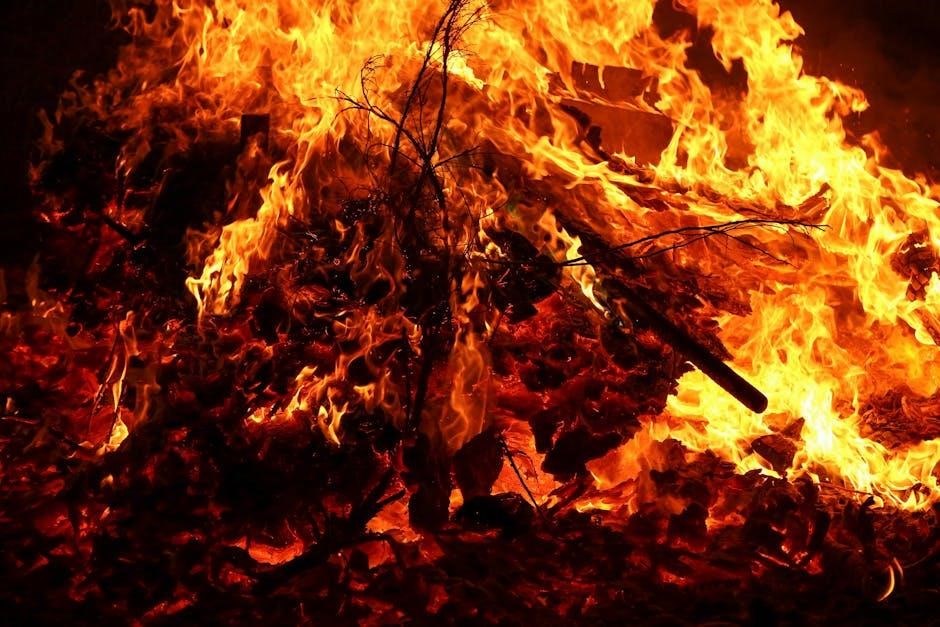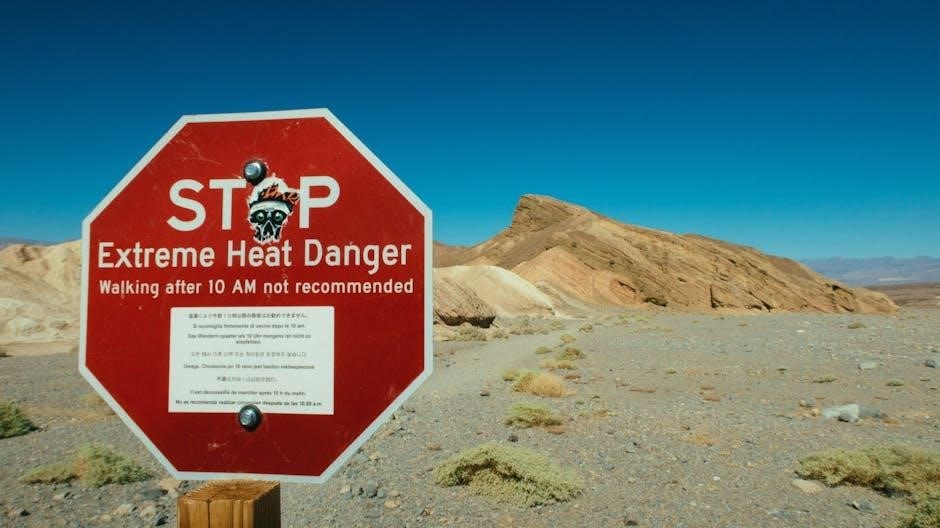A printable heat press temperature guide is essential for achieving precise results in heat transfer projects. It outlines optimal time, temperature, and pressure settings for various materials, ensuring consistent outcomes and avoiding common issues like overheating or underheating. This guide covers HTV, sublimation, DTF, and more, making it a must-have tool for crafters and professionals alike.
What is a Heat Press?
A heat press is a machine designed to transfer designs onto various materials using heat, time, and pressure. It is commonly used for applying heat transfer vinyl (HTV), sublimation prints, and direct-to-film (DTF) transfers onto fabrics, plastics, and other surfaces; The heat press works by applying controlled temperature and pressure to ensure the design adheres properly to the material. It is a versatile tool for crafting, customization, and professional garment decoration. Unlike iron-on methods, a heat press provides consistent results due to its precise settings, making it ideal for both hobbyists and businesses. Understanding how to use a heat press correctly is key to achieving durable, high-quality designs.
Why Temperature Matters in Heat Pressing
Temperature is crucial in heat pressing as it directly affects the quality and durability of the transferred design. Incorrect temperatures can lead to issues such as peeling, fading, or incomplete adhesion. Too low, and the design may not transfer properly; too high, and it can damage the material or cause discoloration. Different materials like HTV, sublimation paper, and DTF require specific temperature ranges to ensure the adhesive properties activate correctly. Using a printable heat press temperature guide helps in setting the right temperature, preventing wasted materials and ensuring professional-looking results. Proper temperature control is essential for achieving vibrant, long-lasting designs on fabrics and other surfaces.
Factors Influencing Heat Press Temperature Settings
Temperature settings are influenced by fabric type, material thickness, and the specific transfer method used, such as HTV, sublimation, or DTF. Proper settings ensure optimal results.

Fabric Type and Thickness
Fabric Type and Thickness
Fabric type and thickness significantly impact heat press temperature settings. Different materials, such as cotton, polyester, or blends, require specific temperatures to ensure proper adhesion without damaging the fabric. Thicker fabrics like denim may need higher temperatures and longer press times, while thinner materials, such as silk or rayon, require lower heat to prevent scorching. Understanding the fabric’s thermal tolerance is crucial for achieving durable, vibrant designs. For example, cotton fabrics typically range between 300°F to 330°F, while polyester may require slightly lower temperatures. Always consult a printable heat press guide to match fabric type with the ideal temperature setting for best results.
Material Type (HTV, Sublimation, DTF, etc.)
Material type plays a critical role in determining heat press temperature settings. Heat Transfer Vinyl (HTV) typically requires temperatures between 280°F to 320°F, depending on the brand and finish. Sublimation paper, on the other hand, works best at lower temperatures, around 350°F to 400°F, to avoid damaging the transfer. Direct-to-Film (DTF) transfers need higher temperatures, often between 300°F to 350°F, to ensure the adhesive properly bonds with the fabric. Each material has specific thermal requirements to achieve optimal results, making it essential to reference a printable heat press guide for precise settings. Proper temperature calibration ensures vibrant, long-lasting designs without material degradation.

Heat Press Temperature Guide for Common Materials
A printable heat press guide provides precise temperature settings for materials like HTV, sublimation, and DTF, ensuring optimal results for various heat transfer projects.
Heat Transfer Vinyl (HTV)
Heat Transfer Vinyl (HTV) requires specific temperature settings to ensure proper adhesion and durability. Typically, HTV is pressed at 280-300°F (138-149°C) for 10-15 seconds. The exact temperature and time may vary depending on the type of HTV and the fabric it’s being applied to. Thicker HTV types may need higher temperatures, while thinner ones require lower settings. It’s crucial to preheat the fabric before applying HTV to ensure even heat distribution. Overheating can cause the vinyl to peel or crack, while underheating may result in weak adhesion. Always refer to a printable heat press guide for precise settings tailored to your material.
Sublimation Paper
Sublimation paper requires precise temperature settings to transfer vibrant, long-lasting designs onto materials like polyester fabrics, ceramics, or metal. Typically, sublimation pressing is done at 385-400°F (196-204°C) for 40-60 seconds. The pressure should be firm to ensure full contact between the paper and the substrate. Overheating can cause colors to fade or shift, while underheating may result in incomplete transfers. It’s essential to use a printable heat press guide to adjust settings based on the substrate’s thickness and type. Always allow the paper to cool slightly before peeling to achieve the best results and prevent ghosting or ink migration.
DTF (Direct-to-Film)
DTF (Direct-to-Film) transfers are applied using a heat press at temperatures between 265°F and 300°F (129°C to 149°C) for 10-15 seconds; The pressure should be moderate to ensure proper adhesion without damaging the film. DTF is known for its durability and vibrant colors, making it ideal for various fabrics, including cotton, polyester, and blends. However, overheating can cause the film to separate or discolor. It’s crucial to follow the manufacturer’s guidelines for specific DTF products, as settings may vary. Always pre-press the fabric to remove moisture and ensure a smooth transfer. Proper cooling before peeling is also recommended for optimal results.

Optimal Temperature Ranges for Different Fabrics
Fabrics like cotton, polyester, and blends require specific heat press temperatures. Cotton typically needs 260-300°F, while polyester ranges from 240-280°F. Thicker fabrics may require higher settings for proper adhesion.
Cotton Fabrics
Cotton fabrics are a popular choice for heat pressing due to their durability and ability to hold vibrant designs. The ideal temperature for cotton typically ranges between 260°F to 300°F (126°C to 149°C). Lower temperatures may result in incomplete adhesion, while excessive heat can scorch the fabric. It’s crucial to pre-wash cotton garments to remove any finishes that might interfere with the heat transfer process. Pressing time usually varies between 10 to 15 seconds, depending on the thickness of the fabric and the type of transfer material being used. Always refer to a printable heat press guide for specific settings tailored to your project.
Polyester Fabrics
Polyester fabrics require careful temperature control for heat pressing to avoid damage. The recommended temperature range is typically between 260°F to 300°F (126°C to 149°C), with lower settings for thinner fabrics and higher for thicker ones. Overheating can cause polyester to melt or discolor, so precision is key. Pressing times generally range from 10 to 20 seconds, depending on the material and design complexity. For sublimation transfers, slightly lower temperatures are often preferred to prevent ghosting. Always consult a printable heat press guide for specific settings tailored to your polyester fabric type and transfer material to ensure a flawless finish and durability of the design.
How to Read a Heat Press Temperature Chart
A heat press temperature chart guides users to set the correct temperature, time, and pressure for materials like HTV, ensuring optimal results for every project.
Understanding Time, Temperature, and Pressure Settings
Time, temperature, and pressure are the cornerstone of successful heat pressing. Temperature determines how well the material adheres, while time ensures proper bonding without overheating. Pressure guarantees even contact. These settings vary by material type, such as HTV or sublimation, and fabric thickness. A printable guide provides clear recommendations, ensuring consistency. For example, HTV typically requires 300-320°F for 10-15 seconds with medium pressure. Sublimation may need higher temperatures but shorter times. Adjusting these settings incorrectly can lead to peeling, discoloration, or fabric damage. A chart simplifies this process, offering a quick reference for optimal results across different projects and materials.

Best Practices for Adjusting Heat Press Settings
Always test settings on scrap fabric first to ensure consistency. Monitor the press’s temperature accuracy and start with lower settings, gradually increasing to avoid overheating materials.
Tips for Achieving Consistent Results
To achieve consistent results with your heat press, always preheat the press to the recommended temperature before starting. Ensure the fabric is dry and free of wrinkles. Use a printable heat press temperature guide as a quick reference for settings. Invest in a temperature gun to verify accuracy. Test settings on scrap fabric first to avoid ruining your final product. Document successful settings for future projects. For intricate designs, apply even pressure and avoid overloading the press. Keep the press clean to prevent residue buildup. By following these tips, you can master heat pressing and achieve professional-quality results every time.
Common Mistakes to Avoid
- Overheating can damage materials and ruin designs.
- Underheating may result in incomplete transfers.
- Using incorrect pressure settings can cause uneven adhesion.
Overheating and Underheating Issues
Overheating and underheating are common pitfalls in heat pressing that can ruin your designs and damage materials. Overheating causes discoloration, bubbling, or even charring of fabrics, while underheating leads to incomplete transfers or peeling. Both issues stem from incorrect temperature settings or uneven heat distribution. To avoid these problems, refer to a printable heat press temperature guide, which provides precise settings for specific materials. Regularly calibrate your heat press and monitor its performance to ensure consistent results. Adjusting time and pressure settings alongside temperature can also help prevent overheating and underheating, ensuring your designs last long and look professional.
A printable heat press temperature guide ensures consistency, prevents overheating, and avoids common mistakes, helping achieve professional results every time. Keep it handy for quick reference.
Importance of Using a Printable Heat Press Guide
A printable heat press temperature guide is invaluable for ensuring precise and consistent results in heat transfer projects. It eliminates guesswork by providing optimal temperature, time, and pressure settings for various materials like HTV, sublimation, and DTF. This tool helps avoid common mistakes such as overheating or underheating, which can ruin designs. By following the guide, crafters and professionals can achieve professional-quality transfers every time. It also serves as a quick reference, saving time and reducing waste. Whether you’re working with cotton, polyester, or specialized fabrics, a printable guide ensures efficiency and perfection in every project.
